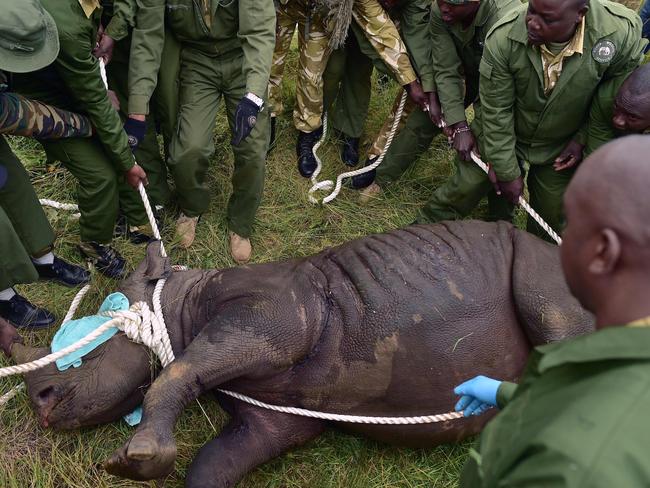Relocation mayhem causes seven black rhinos to die vain in Kenya
SEVEN critically endangered black rhinos have died in vain after officials cited negligence is in their relocation process in Kenya.
SEVEN critically endangered black rhinos are dead in Kenya following an attempt to move them from the capital to a national park hundreds of kilometres away, a wildlife official said Friday.
The official, speaking on condition of anonymity because he was not authorised to release the information, cited what he called “negligence” in the deaths.
Losing the rhinos is “a complete disaster,” said prominent Kenyan conservationist Paula Kahumbu of WildlifeDirect.
Conservationists in Africa have been working hard to protect the black rhino subspecies from poachers targeting them for their horns to supply an illegal Asian market.

In moving the rhinos to Tsavo East National Park from Nairobi last month, the Kenya Wildlife Service said it hoped to boost the population there. The government agency, which has conducted numerous successful moves in the past, has not said how the rhinos died.
Kenya is home to 80 per cent of the black rhinos’ remaining global population, Kahumbu said.
“Moving rhinos is complicated, akin to moving gold bullion, it requires extremely careful planning and security due to the value of these rare animals,” she said in a statement.
“Rhino translocations also have major welfare considerations and I dread to think of the suffering that these poor animals endured before they died. We need to know what went wrong so that it never happens again.”


Transporting wildlife is a strategy used by conservationists to help build up, or even bring back, animal populations. In May, six black rhinos were moved from South Africa to Chad, restoring the species to the country in north-central Africa nearly half a century after it was wiped out there.
According to WWF, black rhino populations declined dramatically in the 20th century, mostly at the hands of European hunters and settlers. Between 1960 and 1995, numbers dropped by 98 per cent, to fewer than 2,500.
Since then the species has rebounded, although it remains extremely threatened. In addition to poaching, the animals face habitat loss.

African Parks, a Johannesburg-based conservation group, said earlier this year that there are fewer than 25,000 rhinos in the African wild, of which about 20 per cent are black rhinos and the rest white rhinos.
In another major setback for conservation, the last remaining male northern white rhino on the planet died in March in Kenya, leaving conservationists struggling to save that subspecies using in vitro fertilisation.



